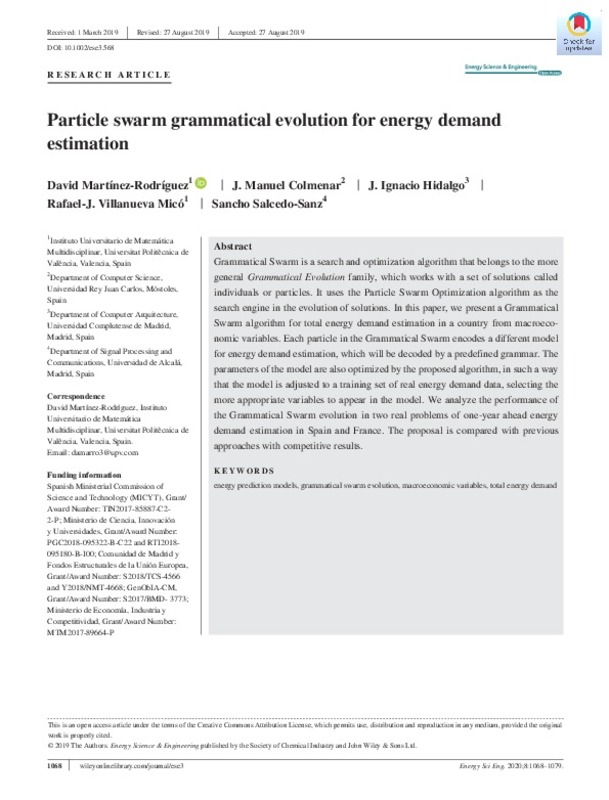Safarzyńska, K., & van den Bergh, J. C. J. M. (2017). Integrated crisis-energy policy: Macro-evolutionary modelling of technology, finance and energy interactions. Technological Forecasting and Social Change, 114, 119-137. doi:10.1016/j.techfore.2016.07.033
Li, F., Song, Z., & Liu, W. (2014). China’s energy consumption under the global economic crisis: Decomposition and sectoral analysis. Energy Policy, 64, 193-202. doi:10.1016/j.enpol.2013.09.014
Salcedo-Sanz, S., Muñoz-Bulnes, J., Portilla-Figueras, J. A., & Del Ser, J. (2015). One-year-ahead energy demand estimation from macroeconomic variables using computational intelligence algorithms. Energy Conversion and Management, 99, 62-71. doi:10.1016/j.enconman.2015.03.109
[+]
Safarzyńska, K., & van den Bergh, J. C. J. M. (2017). Integrated crisis-energy policy: Macro-evolutionary modelling of technology, finance and energy interactions. Technological Forecasting and Social Change, 114, 119-137. doi:10.1016/j.techfore.2016.07.033
Li, F., Song, Z., & Liu, W. (2014). China’s energy consumption under the global economic crisis: Decomposition and sectoral analysis. Energy Policy, 64, 193-202. doi:10.1016/j.enpol.2013.09.014
Salcedo-Sanz, S., Muñoz-Bulnes, J., Portilla-Figueras, J. A., & Del Ser, J. (2015). One-year-ahead energy demand estimation from macroeconomic variables using computational intelligence algorithms. Energy Conversion and Management, 99, 62-71. doi:10.1016/j.enconman.2015.03.109
Sánchez-Oro, J., Duarte, A., & Salcedo-Sanz, S. (2016). Robust total energy demand estimation with a hybrid Variable Neighborhood Search – Extreme Learning Machine algorithm. Energy Conversion and Management, 123, 445-452. doi:10.1016/j.enconman.2016.06.050
Ceylan, H., & Ozturk, H. K. (2004). Estimating energy demand of Turkey based on economic indicators using genetic algorithm approach. Energy Conversion and Management, 45(15-16), 2525-2537. doi:10.1016/j.enconman.2003.11.010
Shaik, S., & Yeboah, O.-A. (2018). Does climate influence energy demand? A regional analysis. Applied Energy, 212, 691-703. doi:10.1016/j.apenergy.2017.11.109
United Nations Climate Change Conference.The Paris Agreement. UNTC XXVII 7.d.
Suganthi, L., & Samuel, A. A. (2012). Energy models for demand forecasting—A review. Renewable and Sustainable Energy Reviews, 16(2), 1223-1240. doi:10.1016/j.rser.2011.08.014
Geem, Z. W., & Roper, W. E. (2009). Energy demand estimation of South Korea using artificial neural network. Energy Policy, 37(10), 4049-4054. doi:10.1016/j.enpol.2009.04.049
Ünler, A. (2008). Improvement of energy demand forecasts using swarm intelligence: The case of Turkey with projections to 2025. Energy Policy, 36(6), 1937-1944. doi:10.1016/j.enpol.2008.02.018
Kıran, M. S., Özceylan, E., Gündüz, M., & Paksoy, T. (2012). Swarm intelligence approaches to estimate electricity energy demand in Turkey. Knowledge-Based Systems, 36, 93-103. doi:10.1016/j.knosys.2012.06.009
Kıran, M. S., Özceylan, E., Gündüz, M., & Paksoy, T. (2012). A novel hybrid approach based on Particle Swarm Optimization and Ant Colony Algorithm to forecast energy demand of Turkey. Energy Conversion and Management, 53(1), 75-83. doi:10.1016/j.enconman.2011.08.004
Yu, S., Wei, Y.-M., & Wang, K. (2012). A PSO–GA optimal model to estimate primary energy demand of China. Energy Policy, 42, 329-340. doi:10.1016/j.enpol.2011.11.090
Yu, S., Zhu, K., & Zhang, X. (2012). Energy demand projection of China using a path-coefficient analysis and PSO–GA approach. Energy Conversion and Management, 53(1), 142-153. doi:10.1016/j.enconman.2011.08.015
Yu, S., & Zhu, K. (2012). A hybrid procedure for energy demand forecasting in China. Energy, 37(1), 396-404. doi:10.1016/j.energy.2011.11.015
Geng, Z., Zeng, R., Han, Y., Zhong, Y., & Fu, H. (2019). Energy efficiency evaluation and energy saving based on DEA integrated affinity propagation clustering: Case study of complex petrochemical industries. Energy, 179, 863-875. doi:10.1016/j.energy.2019.05.042
Han, Y., Long, C., Geng, Z., Zhu, Q., & Zhong, Y. (2019). A novel DEACM integrating affinity propagation for performance evaluation and energy optimization modeling: Application to complex petrochemical industries. Energy Conversion and Management, 183, 349-359. doi:10.1016/j.enconman.2018.12.120
Han, Y., Wu, H., Jia, M., Geng, Z., & Zhong, Y. (2019). Production capacity analysis and energy optimization of complex petrochemical industries using novel extreme learning machine integrating affinity propagation. Energy Conversion and Management, 180, 240-249. doi:10.1016/j.enconman.2018.11.001
Colmenar, J. M., Hidalgo, J. I., & Salcedo-Sanz, S. (2018). Automatic generation of models for energy demand estimation using Grammatical Evolution. Energy, 164, 183-193. doi:10.1016/j.energy.2018.08.199
O’Neill, M., & Brabazon, A. (2006). Grammatical Swarm: The generation of programs by social programming. Natural Computing, 5(4), 443-462. doi:10.1007/s11047-006-9007-7
O’Neill, M., & Ryan, C. (2001). Grammatical evolution. IEEE Transactions on Evolutionary Computation, 5(4), 349-358. doi:10.1109/4235.942529
KennedyJ EberhartR.Particle swarm optimization. Vol.4. Proceedings of ICNN'95 - International Conference on Neural Networks.Perth WA;1995:1942‐1948.https://doi.org/10.1109/ICNN.1995.488968
Tsoulos, I. G., Gavrilis, D., & Glavas, E. (s. f.). Neural network construction using grammatical evolution. Proceedings of the Fifth IEEE International Symposium on Signal Processing and Information Technology, 2005. doi:10.1109/isspit.2005.1577206
Beni, G., & Wang, J. (1993). Swarm Intelligence in Cellular Robotic Systems. Robots and Biological Systems: Towards a New Bionics?, 703-712. doi:10.1007/978-3-642-58069-7_38
Krause, J., Ruxton, G. D., & Krause, S. (2010). Swarm intelligence in animals and humans. Trends in Ecology & Evolution, 25(1), 28-34. doi:10.1016/j.tree.2009.06.016
Marini, F., & Walczak, B. (2015). Particle swarm optimization (PSO). A tutorial. Chemometrics and Intelligent Laboratory Systems, 149, 153-165. doi:10.1016/j.chemolab.2015.08.020
Ling, C. X. (1995). Overfitting and generalization in learning discrete patterns. Neurocomputing, 8(3), 341-347. doi:10.1016/0925-2312(95)00050-g
[-]









